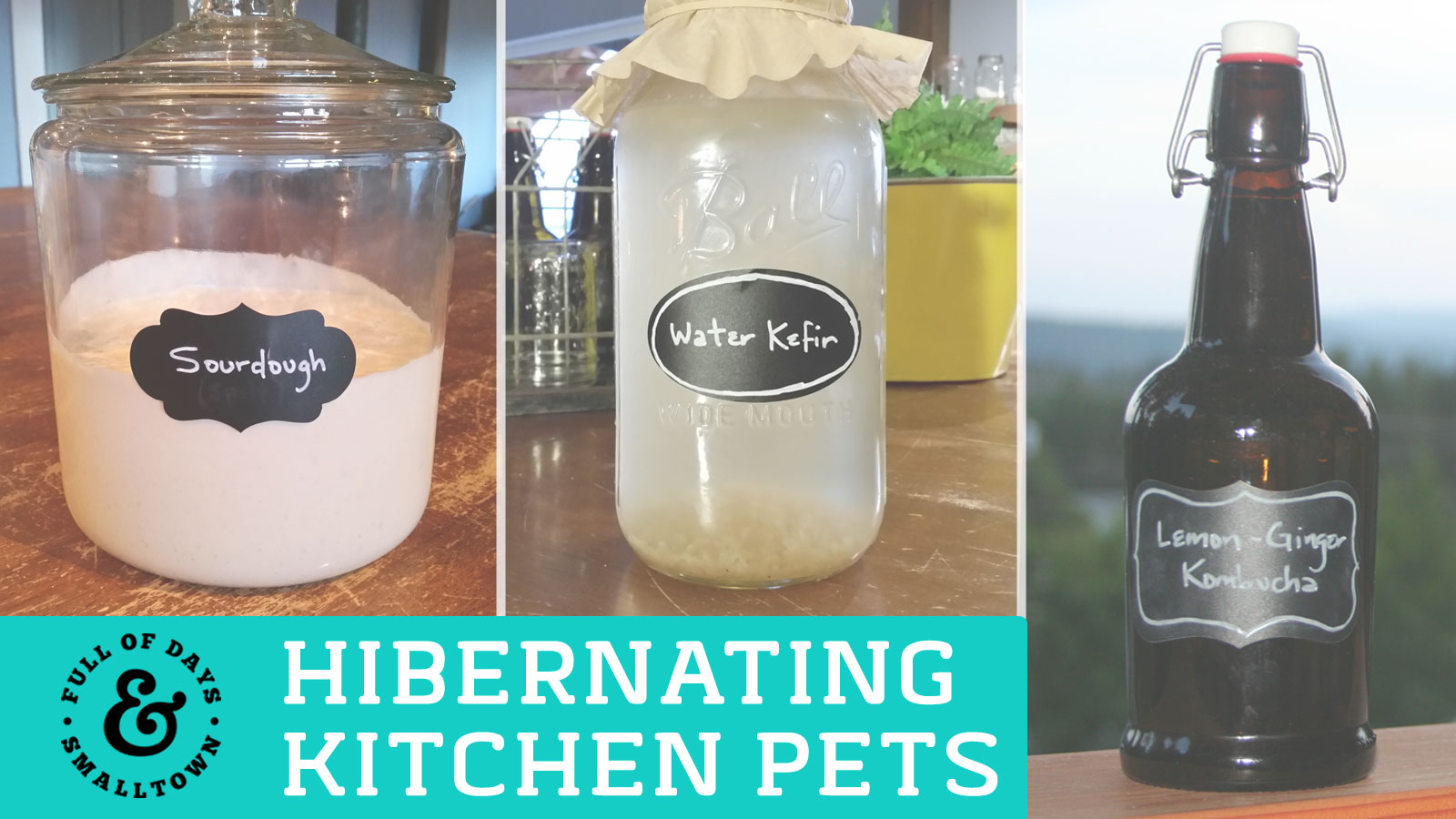
s I was packing up my Kitchen Pets, tucking them in to hibernate for our two-week vacation, I realized I haven’t introduced you to all our pets! I then realized how many of you, like me, may get a wee-bit nervous putting your pets to bed, always leery they’ll never wake up again.
The good news is, if done sparingly, and stored correctly, most SCOBY’s, cultures and ferments can successfully hibernate for extended periods of time. This is great news if you want to start fermenting but have a family vacation coming up. Or if there are seasons where keeping all your ferments going just isn’t possible (ahem, pregnancy).
Below I’ll introduce you to our pets, and list how to properly “hibernate” them for differing lengths of time. Do remember, these kitchen pets are alive and don’t like extreme temperature swings. Letting them “chill out” in the refrigerator from time-to-time is OK, but don’t make a frequent habit of it (with the exception of sourdough which does well with frequent refrigeration).
KOMBUCHA
Kevin is our kombucha who generally takes 7-30 days to ferment. Because of the long fermentation, it may not be necessary to hibernate your kombucha at all. How long ago did you make your last batch? How long do you want it to hibernate? These questions will help you determine what you should do with your kombucha while away on vacation.
- To hibernate for 1-2 weeks: You may get away with leaving your kombucha on the counter to finish fermenting. If you just made a fresh batch you’ll have ready-to-drink kombucha awaiting upon your return! JOY! If your kombucha is already a couple weeks old, just plan on making a fresh batch when you return, using your kombucha for starter tea.
- To hibernate for 3-4 weeks: Again, you may get away with leaving your kombucha on the counter and starting a fresh batch when you return. Chances are your kombucha will be quite strong, but you could always try a second ferment, adding some sweet flavorings to help offset the strong flavor. Alternatively, remove your SCOBY and enough starter tea (preferrably 2 cups or more) and store in a clean quart or half gallon sized mason jar. Secure with a lid and store in the fridge.
- To hibernate for 2-6 months: Follow above instructions and feed with 1/4 cup sugar every month. (I have successfully allowed my kombucha to hibernate for about 9 months without feeding it any sugar, but this may have been a fluke! I do recommend occasional feedings just to be on the safe side.)
WATER KEFIR
Stokely (THE best video of 2015!), our water kefir, tends to be a bit more finicky and doesn’t like frequent hibernation. The grains tend to be quite picky with their temperature and feeding schedules, so hibernate only as a last resort!
- To hibernate for 1-4 weeks: Make a fresh batch of water kefir (following these instructions) and store in the refrigerator.
- To hibernate for 2-4 months: Make a fresh batch of water kefir and feed with 1/2 cup sugar every month.
- I wouldn’t recommend hibernating any longer than four months…if a longer break is needed maybe you could “gift” your grains to a friend who would be happy to enjoy them? Kefir grains have a tendency to multiply over time (I’ve had grains that multiply and grains that don’t, not sure why that is…), maybe by the time you’re ready to start up your kefir, your friend will have enough to gift back to you.
MILK KEFIR
Keifer (Sutherland – snort!), our milk kefir, has always been a happy hibernator, but he does take a bit longer to “wake up” than others. You may have to make 2 or 3 batches before your grains are active enough to make kefir in the usual 24-48 hours.
- To hibernate for 1-4 weeks: Make a fresh batch of milk kefir (following these instructions) and store in the refrigerator.
- To hibernate for 2-12 months: Make a fresh batch of milk kefir and store in the refrigerator. Strain grains and add to a fresh glass of milk each month.
SOURDOUGH STARTER
Seymore, our sourdough starter, is one ferment that can be refrigerated with frequency. Because I’m baking sourdough bread 2-3 times a week, I don’t have the need to refrigerate our starter between baking. However, if you, like many people, only want to bake bread once a week and don’t want the hassle of daily feedings, you can refrigerate your starter between each use. Simply remove the starter and feed it 3-4 times (4-6 hours between feedings) before baking.
Short-term hibernation – 1 to 2 weeks
- To hibernate your sourdough starter, all you need to do is take freshly fed starter (about a cup will do) and store it with an airtight lid in the refrigerator. Ideally, you’ll want to feed it once a week, but because sourdough is so resilient, you can likely leave it for 2 weeks and be just fine.
Short-term hibernation – 2-4 weeks
- To hibernate your starter for 2-4 weeks you’ll want to lower the hydration level of your starter (also called making a dry starter). To do this, take about ⅔ cup starter and 2 cups flour. Using your hands, mix the flour into the starter until it’s dry and crumbly (add more flour if needed). Store in an airtight jar in the refrigerator for up to a month.
- When you’re ready to start baking again, remove the starter from the fridge and add one cup warm water. Stir well, cover and leave at room temperature until the water is absorbed (about 30 minutes). Check consistency and, if needed, add additional warm water until it’s back to its original consistency. Feed normally for a total of three feedings before baking.
Long-term hibernation – up to 1 year
We get that life happens and sometimes you need to take a longer break from sourdough baking. But if you don’t want to have to reinvest in new starter once you’re ready to bake again, then we recommend dehydrating a small portion of your starter and storing it in the freezer until you’re ready to resume feedings. This is a perfect remedy if you’re expecting a baby, moving to a new home, or are just really burned out on baking!
- To dehydrate your starter, take a small amount of active starter and spread it onto a piece of parchment paper. Leave starter at room temperature until it’s completely dry (and separates from the parchment). Grind the dried starter and store in an airtight container in the freezer (be sure to mark what it is and the date!).
- When ready to bake again, combine ¼ cup flour, ¼ cup water and approximately 1 Tablespoon of dried sourdough starter to a jar. Stir well, cover and let sit for 12-18 hours. For the next feeding, add ½ cup flour and ½ cup water to the starter, stir well, cover and let sit for another 12 hours. For all future feedings you’ll want to feed every 8-12 hours with the following ratio – 1 part starter, 1 part water and scant 2 parts flour. Once your starter is active and bubbly (usually after 3-7 days of feedings), it’s ready to use!
FERMENTED VEGGIES
Fermented veggies like sauerkraut, kimchi or this spicy pineapple salsa require a 2-14 day incubation period before moving to cold storage or the refrigerator. If you’re planning to go out of town, hold of on making any ferments before you leave. If you’re needing to pack away all those heads of cabbage you harvested from your garden before going on vacation, see if you can have a friend come over and transfer your containers to cold storage while you’re gone. Once your ferments are in cold storage, you’re generally good for months on end as fermented veggies tend to get more flavorful after hibernating for a couple months (or more!).
Hopefully reading this post gives you the knowledge and confidence you need to start fermenting at home! Procuring “kitchen pets” is a delicious, healthy and inexpensive way to incorporate gut-healing probiotics into your diet.


